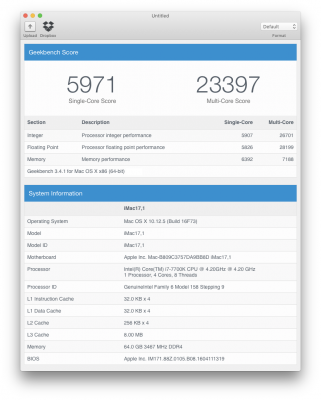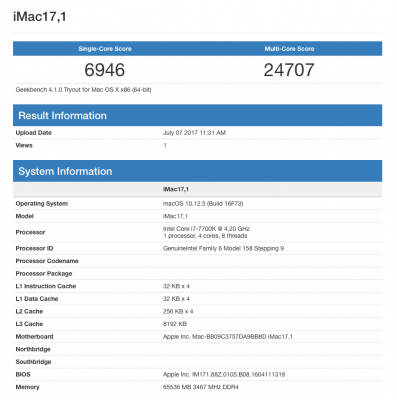As I’d mentioned earlier, I scored an i7-7700K CPU for $280 recently. Originally, I had planned on waiting for Apple to release macOS Sierra 10.12.6 because it offered official support for Kaby Lake, but all the talk recently got me worked up and I couldn’t wait anymore… So, I decided to go ahead with the upgrade ahead of the 10.12.6 release.
I didn’t even bother with testing the CPU and just went right to delidding it as I had previously done with my i7-6700K. This time around, I think I did a neater job. When I removed the old CPU, I had to clean off the old liquid metal from the CPU and heatsink. It wasn’t hard, just a bit messy.
BIOS version 2202 did allow me to boot with the i7-7700K, but the system acted strangely. The Asus A.I. Suite was not able to overclock the CPU properly. I really, really wanted to stay with 2202 for the native NVRAM but it just didn’t work well.
With great reluctance, I upgraded the BIOS to 3401. Now, the A.I. Suite was finally able to properly overclock the CPU and I walked away with a stable 5.1GHz. Temperatures seem to be about 4-5C hotter than my old i7-6700K with lows at idle at about 33C to about 77C at full load. I continue to use the same Noctua NH-D15S which has proven to be extremely efficient and amazingly quiet.
Since macOS Sierra 10.12.5 doesn’t have native support for Kaby Lake, I had to use FakeCPUID in my config.plist and create a new ssdt.aml. Secondly, I had to install the EmuVariableUefi-64.efi and RC scripts because I upgraded my BIOS. The last thing I needed to do was install FakePCIID.kext and FakePCIID_Intel_HD_Graphics.kext for Quick Sync to work. That’s it. No other changes needed to be made for macOS to continue to work as it had.
Recap of what needed to be done to make i7-7700K work with my existing install:
- Upgrade BIOS to 3401. (for better Kaby Lake CPU support)
- Use FakeCPUID in config.plist. (to fake Skylake CPU)
- Create new ssdt.aml. (for better speed step and power management)
- Install EmuVariableUefi-64.efi and RC Scripts. (needed for BIOS 3401)
- Install FakePCIID.kext and FakePCIID_Intel_HD_Graphics.kext. (for Quick Sync to work)
As per my usual modus operandi, I didn’t bother to do a clean install as I didn’t think it was necessary. In my brief testing, everything continues to work as it had including sleep/wake, Quick Sync, iBooks, Messages/Continuity, etc. Once macOS Sierra 10.12.6 is released, I should be able to just remove the FakeCPUID and continue rolling along.
Previously, I had looked in to the new 200-series motherboards but decided against it because, apparently, the new Kaby Lake iMacs are still using Z170 chipset. Also, it would save me a few bucks and quite a few hours from the hardware install and software tweaking to achieve this level of stability.
View attachment 265792 View attachment 265793



